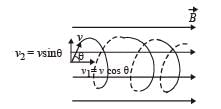JEE Advanced (Fill in the Blanks): Moving Charges & Magnetism | Chapter-wise Tests for JEE Main & Advanced PDF Download
Q.1. A neutron, a proton, and an electron and an alpha particle enter a region of constant magnetic field with equal velocities.The magnetic field is along the inward normal to the plane of the paper. The tracks of the particles are labelled in fig.The electron follows track ...... and the alpha particle follows track .....

Ans. D, B
Solution. According to Fleming's left hand rule, the force on electrons will be towards right (D).
Also, by the same rule we find that the force on proton and a-particle is towards left. Now since the magnetic force will behave as centripetal force, therefore


∴ radius will be more for α-particle
∴α-particle will take path B.
Q.2. A wire of length L metre, carrying a current i ampere is bent in the form of a circle. The magnitude of its magnetic moment is ........in MKS units.
Ans.
Solution.

Wire of length L is bent in the form of a circle. Then the perimeter of the circle

Magnetic moment of a loop in which current i flows is given by

Q.3. In a hydrogen atom, the electron moves in an orbit of radius 0.5 Å making 1016 revolutions per second. The magnetic moment associated with the orbital motion of the electron is ......
Ans. 1.25 × 10–23 Am2
Solution.


Q.4. The wire loop PQRSP formed by joining two semicircular wires of radii R1 and R2 carries a current I as shown. The magnitude of the magnetic induction at the centre C is ....................

Ans.
Solution. The magnetic field at C due to current in PQ and RS is zero. Magnetic field due to current in semi-circular arc QAR

directed towards reader perpendicular to the plane of paper.

Magnetic field due to current in semi-circular arc

directed away from reader perpendicular to the plane of paper.

(directed towards the reader perpendicular to plane of paper).

Q.5. A wire ABCDEF (with each side of length L) bent as shown in figure and carrying a current I is placed in a uniform magnetic induction B parallel to the positive y-direction.
The force experienced by the wire is ............ in the ............. direction.

Ans. IlB; +Z direction
Solution. We may assume current to be flowing in segment EB in both directions.
Net force on the loop EDCBE will be zero. Also force due to segment FE and BA will be zero. Force due to segment EB

Q.6. A metallic block carrying current I is subjected to a uniform magnetic induction  shown in Figure .
shown in Figure .

The moving charges experience a force  given by .... which results in the lowering of the potential of the face .... Assume the speed of the carriers to be v.
given by .... which results in the lowering of the potential of the face .... Assume the speed of the carriers to be v.
Ans. evB; ABCD
Solution. 
NOTE : The direction of flow of electrons is opposite to that of current.
Q.7. No net force acts on a rectangular coil carrying a steady current when suspended freely in a uniform magnetic field.
Ans. T
Solution. A current carrying coil is a magnetic dipole. The net force on a magnetic dipole placed in uniform magnetic field is zero.
Q.8.There is no change in the energy of a charged particle moving in a magnetic field although a magnetic force is acting on it.
Ans. T
Solution.
NOTE : The magnetic force acts in a direction perpendicular to the direction of velocity and hence it cannot change the speed of the charged particle. Therefore, the kinetic energy  does not change.
does not change.
Q.9. A charged particle enters a region of uniform magnetic field at an angle of 85° to the magnetic line of force . The path of the particle is a circle.
Ans. F
Solution. The velocity component v2 will be responsible in moving the charged particle in a circle.

The velocity component v1 will be responsible in moving the charged particle in horizontal direction. Therefore the charged particle will travel in a helical path.
Q.10. An electron and a proton are moving with the same kinetic energy along the same direction. When they pass through a uniform magnetic field perpendicular to the direction of their motion, they describe circular paths of the same radius.
Ans. F
Solution. When a charged particle passes through a uniform magnetic field perpendicular to the direction of motion, a force acts on the particle perpendicular to the velocity. This force acts as a centripetal force


Here, q is same for electron and proton

Radius of proton will be more.
|
446 docs|929 tests
|
















